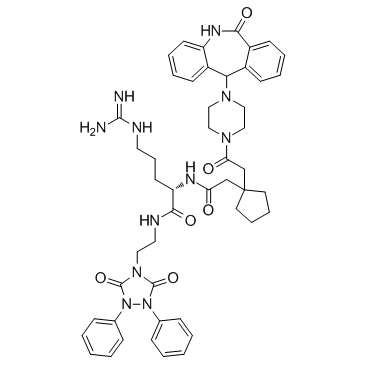246146-55-4
| Name | (2S)-5-(diaminomethylideneamino)-N-[2-(3,5-dioxo-1,2-diphenyl-1,2,4-triazolidin-4-yl)ethyl]-2-[[2-[1-[2-oxo-2-[4-(6-oxo-5,11-dihydrobenzo[c][1]benzazepin-11-yl)piperazin-1-yl]ethyl]cyclopentyl]acetyl]amino]pentanamide |
|---|---|
| Synonyms |
N-Acetyl-O-phosphono-Tyr-Glu Dipentylamide
BIIE-0246 UNII-N3Z657H81X |
| Description | BIIE-0246 is a potent and highly selective non-peptide neuropeptide Y (NPY) Y2 receptor antagonist, with an IC50 of 15 nM. |
|---|---|
| Related Catalog | |
| Target |
NPYY2 receptor:15±3 nM (IC50) |
| In Vitro | Receptor binding assays in HEK 293 cells transfected with the rat Y2 receptor cDNA demonstrate that BIIE-0246 competes with high affinity (IC50=15±3 nM) against specific [125I]PYY3-36 binding sites. In contrast, BIIE-0246, at concentrations up to 10 μM, fails to compete for significant amounts of specific [125I]GR231118, [125I]hPP and [125I][Leu31, Pro34]PYY binding sites in HEK 293 cells transfected with the rat Y1, Y4 or Y5 receptor cDNA, respectively[1]. |
| In Vivo | On chow diet, genetically obese NPY mice show increased gain in body weight and adiposity. Treatment with BIIE-0246 promotes body weight gain in both genotypes after 4.5 weeks, and already at 2 weeks. BIIE-0246 has no significant effect on fat mass gain. In DIO, BIIE-0246 has different effects on body weight and composition depending on the genotype (treatment×genotype interaction in body weight P<0.05, in fat mass P<0.001 and in lean mass P<0.05). In DIO-WT group, post hoc analysis reveals increased body weight and fat mass gain, and a tendency to decrease lean mass gain. In DIO-NPY, BIIE-0246 inhibits fat mass gain (P=0.05). Interestingly, increased cholesterol levels are detected also in WT mice treated with BIIE-0246 for 2 weeks, but not in the 4.5-week cohort. In DIO-NPY mice in both treatment groups, cholesterol levels correlate positively with body fat mass (DIO-NPY vehicle P<0.01; DIO-NPY BIIE-0246 P<0.001), but not in any other group, and the slope of the regression curve of cholesterol and fat mass is significantly decreased in BIIE-0246-treated DIO-NPY group when compared with vehicle-treated group[2]. |
| Animal Admin | Mice[2] Homozygous transgenic male OE-NPYDbH and WT mice are used. The mice are housed at 21±3°C with a 12-h light/12-h dark cycle. To study the effect of Y2-receptor antagonism in healthy conditions, standard rodent chow is fed ad libitum to OE-NPYDbH (NPY) and WT mice. To study the effect in DIO, western diet is fed for 8 weeks prior to the drug administration. Drug treatment is studied at the age of 20 weeks. Prior to treatments the mice are habituated for 2 weeks to the handling stress with daily saline injections (i.p). Mice receive 1.3 mg/kg of Y2-receptor antagonist (BIIE-0246) or vehicle with daily IP injections. At termination, mice are fasted for 3 h and blood glucose is measured from awake animals. Mice are then anesthetized with ketamine (75 mg/kg i.p) and medetomidine (1 mg/kg i.p). Subcutaneous, epididymal, retroperitoneal and mesenteric white adipose tissue (WAT) pads, interscapular brown adipose tissue (BAT) and liver are collected and weighed[2]. |
| References |
| Molecular Formula | C49H57N11O6 |
|---|---|
| Molecular Weight | 896.04700 |
| Exact Mass | 895.44900 |
| PSA | 221.68000 |
| LogP | 5.48080 |
| Index of Refraction | 1.7 |
| Storage condition | 2-8°C |
